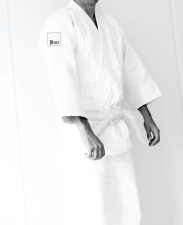
The Jitsu Foundation uniform is know by its Japanese name 'judogi' and comprises
of a re-inforced jacket, trousers and a belt. The principle being that everyone wears
the same uniform and the only distinguishing markings are earned, in the form of
coloured belts, hakama and black 'over-gi'.
A Jitsu Foundation badge is worn on the right upper arm. This is the only permitted
badge and is a condition of grading and participation in events and courses.
The Foundation badge is also an indicator of grade.
Beginners wear loose clothes, often a t-shirt and track suit trousers, however they
often quickly opt to purchase a hard wearing judogi, which start at prices from approx
£15. Beginners wear a white belt.
For hygiene reasons and respect for those that you train with, the judogi should
be washed after each training session and folded in the correct manner to prevent
creasing.
Coloured belts are awarded at gradings and signify a student's position within the
ranking system of The Jitsu Foundation.
The Jitsu Foundation teaches Jiu Jitsu, a contact martial art that requires the concentration
and control of those who wish practice the art.
Due to the nature of any contact activity, the Foundation requires
that all its members abide by a strict and logical code of conduct. This
ensures a safe and happy learning environment for all.
Dojo
This is the room in which you train, it can be a village hall, sports hall, squash
court, but when the mats are down the room then becomes a dojo and correct
rules apply. The dojo floor is covered with reinforced mats known as tatami; used to absorb impact of falls. Footwear must not be worn on the mat.
- bow on entry and exit to the dojo
- no smoking, drinking, swearing, or inappropriate behaviour, treat the dojo as if
it is someone's house and you are a guest
- shoes or zori should be worn when not on the mat
- clean feet
- short finger and toe nails
- clean judogi- remove jewelry
- ask permission stepping before onto the mat
- ask permission to leave the mat & dojo
Rei
This is the name given to the traditional Japanese bow or salutation, similar to
the western shaking hands. The bow should be performed correctly. The standing
bow is performed with feet together, bending forwards at the waist with alignment
of neck and back, hands move down the front of the legs until the body
forms approx 30 degree angle.
The kneeling bow is more formal, and is performed at the beginning and end of
the training session, marking the start and finish of training.
Sensei
This term is the Japanese name for instructor. All instructors are referred to as
sensei. Instructors are those that hold the rank of 1st kyu brown belt and above.
Yamae
Means stop or halt, and must be adhered to immediately for safety reasons.


